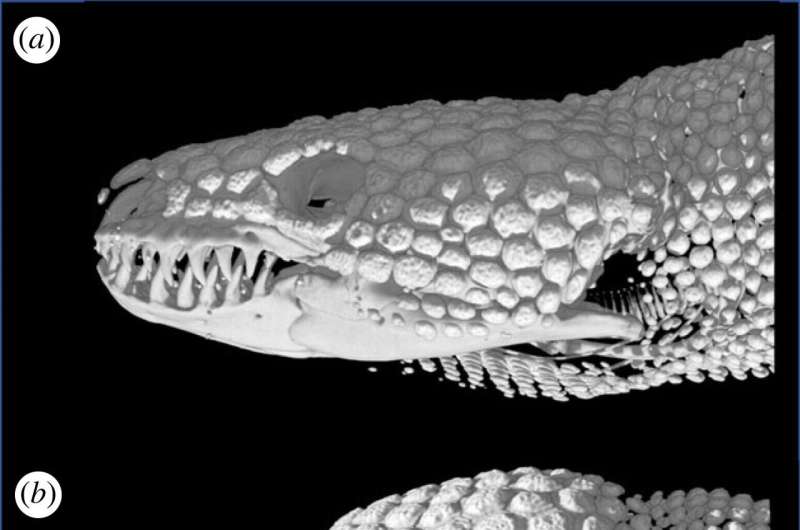This article has been reviewed according to Science X's editorial process and policies. Editors have highlighted the following attributes while ensuring the content's credibility:
fact-checked
peer-reviewed publication
trusted source
proofread
Female Gila monster fights surprisingly violent, study finds

A new study published on May 10 in the journal Royal Society Open Science has shown that in the Gila monster, a large venomous lizard, encounters between females are far more intense and violent than interactions between males.
When male Gila monsters fight, according to corresponding author A. Kristopher Lappin, a professor of Biological Sciences at Cal Poly Pomona, it is largely a ritualized contest.
"The males basically wrestle. They may nip at each other, but as far as we know, they don't aggressively bite each other in a way that can do significant damage. With the females, we know based on the trials that they will bite each other violently. In all of the trials, the females immediately engaged. In three of the four interactions, the encounters had to be broken up before they could do significant damage to each other."
This is the first paper documenting this behavior in the iconic Gila monster, which is native to the American Southwest and northwestern Mexico. Gila monsters are orange and black lizards with bead-like scales and huge teeth. They can grow to almost two feet in length, making them the largest lizard native to the United States.
The study involved adult members in two captive colonies. Behavioral data were combined with data from bite-force experiments to evaluate whether their osteoderms (well-developed bony deposits in their skin) may serve a protective function during aggressive interactions.
In each of the trials, the females first exhibited tongue flicking, hissing, nudging, and scratching, followed by body inflation. "With further escalation, sustained biting occurred, followed by lateral rotation (LR). LR resembles the so-called 'deathroll' of crocodiles," noted the study. Whenever LR was observed, the trial was stopped to avoid potential serious injury. No Gila monster was permanently injured in the trials.
While the authors expected some degree of aggression between females, they were surprised both by how quickly they initiated aggressive behavior and by the complexity and intensity of the aggression. In addition, despite growing literature on venom self-resistance in animals, the Gila monsters that were bitten and envenomated "were noticeably compromised both behaviorally and physically for a lengthy period, though recovery was full without need for medical intervention," according to the study.
No member of the team had previously observed LR or envenomation in male-male aggression in captivity or in the field.
"Gila monsters, despite their iconic status as large, venomous lizards of the southwestern U.S. and northern Mexico, are largely understudied," noted lead author Gordon Schuett, an adjunct professor of biology at Georgia State University who is also affiliated with the Chiricahua Desert Museum in Rodeo, New Mexico. "Interestingly, certain components of their venom have been used in drug design for type-2 diabetes since the early 2000s. This study provides new information on the social structure of a cryptic, threatened species."
In studies of other lizard species, female-female aggression can be related to territorial defense and acquisition, mate defense, and parental care. While this could also be true for Gila monsters, the authors hypothesize that because they are a nest-raiding specialist feeding on eggs, nestlings, and newborn mammals, female aggression in this species may be related to nest defense and function as a method of preventing cannibalism.
In addition to Lappin, three other co-authors have Cal Poly Pomona ties: Anthony Powell ('22, master's in biological sciences) and current lecturer, John Taylor (current grad student), and Jennifer Alexander ('13, master's in biological sciences) and instructional support technician for Rain Bird BioTrek and Organismal Biology).
"Aggression between female Gila monsters," said Lappin, "is a great example of what aggression can look like, how it can be extreme, and how it plays an important role in the social behavior of animals. Aggression between females, like aggression between males, surely has important functions in social structure and reproduction. We hope that this report will encourage more study of this behavior, both in this iconic species and in animals more broadly."
More information: Gordon W. Schuett et al, Female–female aggression in the Gila monster ( Heloderma suspectum ), Royal Society Open Science (2023). DOI: 10.1098/rsos.221466
Journal information: Royal Society Open Science
Provided by California State Polytechnic University





















